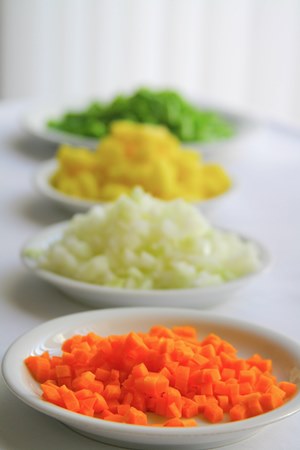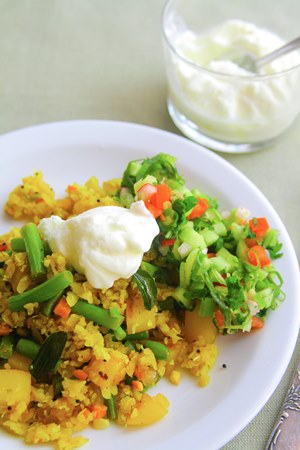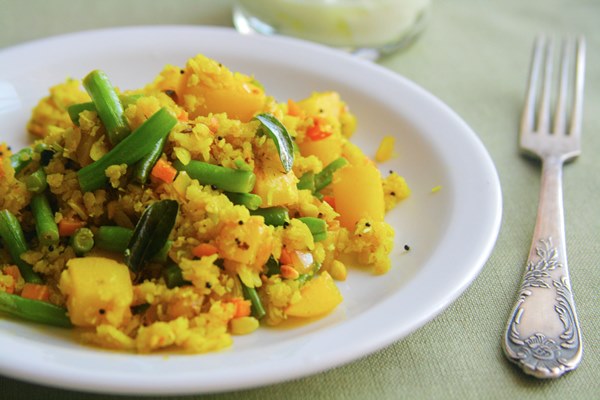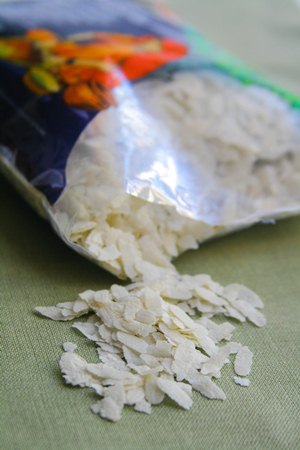
Poha is the name for flattened rice (sometimes also referred to as beaten rice) that has been parboiled, rolled, flattened, and dried to produce easy-to-cook, nutritious flakes. It’s a Western Indian version of muesli, and it’s a common breakfast dish. Since poha is already cooked, it only requires a brief soaking to turn the thin flakes into plump grains. It absorbs liquids and flavors easily, and poha works well in soups, pilafs, salads, and even desserts. You can use it in any dish in which you would have used couscous, adjusting the cooking times accordingly.
Like pasta, poha is a staple in my cupboard, allowing me to throw together a quick meal without much fuss. On weekends, I make it for lunch with its full Indian embellishments. If I can use one word to describe the logic of Indian cuisine as a whole, it would be layering. This is what makes Indian dishes so enjoyable to prepare and eat. Take this recipe for poha, for instance. The mild canvas of poha is embellished by warm flavors–onion, ginger, garlic, and chili–in addition to earthy ones like peanuts, turmeric and mustard seeds. The tartness of lemon creates another dimension, while the milky sweetness of coconut lends further complexity.


Sautéing spices in oil is a uniquely Indian technique to give a vibrant burst of flavor. Mustard seeds taste bitter and pungent when raw, but when sizzled in oil, they develop nutty and caramelized nuances which can’t be achieved in any other way. Because the aromatic components of spices are oil soluble, this technique allows for the flavor to be distributed evenly in the dish. The outcome is rich, but unexpectedly mellow.
Poha is a filling one-dish meal that needs few other accompaniments. Since it’s a dry pilaf, it goes well with yogurt and a crunchy salad. I always serve poha with a mix of chopped cucumbers, tomatoes, and onions and I liberally season with cilantro leaves and lemon juice–another rich layer of flavor.

Indian Flattened Rice Pilaf (Poha)
Poha is available from Indian grocery stores where it can found in two varieties, thin and thick. For this savory pilaf, you need the thick variety. You can vary the vegetables, depending on what you have on hand. Sweet potatoes, green peas, turnip, cauliflower, spinach and zucchini are among my favorites. Be sure to cut firm vegetables like carrots and potatoes into small pieces to ensure they cook quickly.
If you have curry leaves, do use them for their green, zesty flourish. On the other hand, don’t worry if you don’t have all of the ingredients on hand. Poha is a dish that is perfect for experiments, and you can substitute other garnishes and spices.
Serve it with a fresh vegetable salad and thick yogurt on the side.
Serves 4-6
2-3 Tablespoons light vegetable oil
1 teaspoon black mustard seeds
1/2 teaspoon cumin seeds
two branches of curry leaves (optional)
1 medium onion, chopped into small cubes
1/2 teaspoon minced ginger root
1/2 teaspoon minced garlic
1 hot green chili pepper, minced (or to taste)
2 1/2 cups of vegetables cut into small cubes (such as carrot, potato, or green beans cut into 1″ pieces)
1/4 teaspoon ground turmeric
1 teaspoon salt
2 cups thick poha flakes
Garnish
2 Tablespoons lemon juice (or to taste)
2 Tablespoons unsweetened coconut flakes, fresh or dried
2 Tablespoons ground peanuts
minced cilantro leaves for garnish
Rinse poha flakes in water to remove excess starch, drain and set aside. Prepare all of your ingredients before you start cooking.
Heat a saute pan on medium-high heat and add oil. When the oil is hot, add the mustard seeds, cumin seeds and cover the pan; the seeds will sizzle and pop. When the popping begins to subside, turn the heat to medium, add curry leaves (if using) and close the pan again (the leaves will sizzle ferociously). After 10 seconds, add onion, garlic, green chili, ginger and cook until onions lose their raw smell and begin to look transparent, about 5 minutes.
Add the vegetables and stir. Add turmeric and cook till vegetables are soft (or al dente, depending on your taste). Add a spoonful of water to prevent vegetables from sticking.
Add soaked poha, salt and 1/4 cup of water. Stir thoroughly to blend everything together and cook for 5 minutes. Remove from the heat. Add lemon juice, coconut flakes, peanuts and cilantro leaves. Taste and correct the seasonings if needed. Poha should taste tart and zesty. Enjoy!



Post a Comment